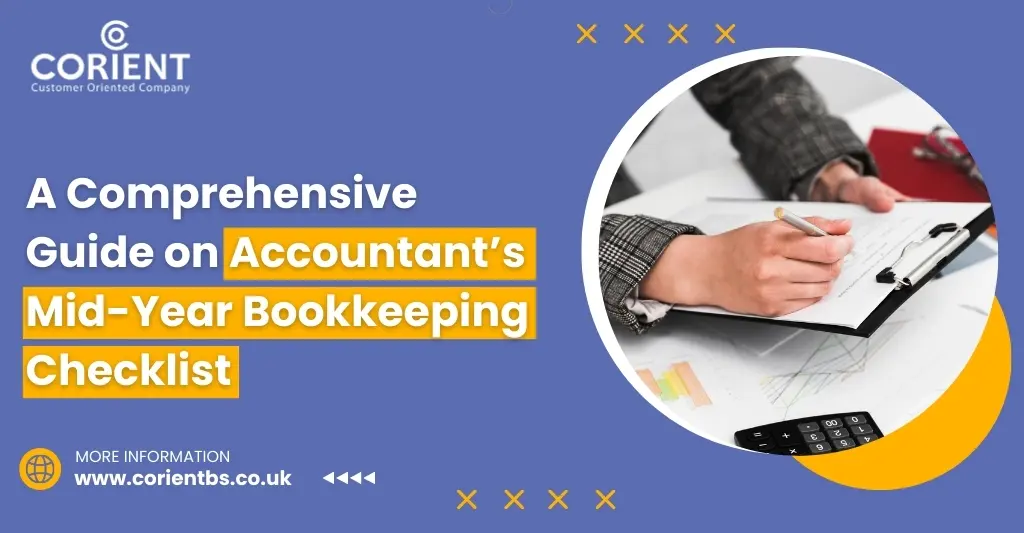
A Comprehensive Guide on Accountant’s Mid-Year Bookkeeping Checklist
- Clear the clutters:
- Marvel the metrics:
- Tax-time:
- Reconcile:
- Technical Time-traveling:
- Chasing Debtors and Creditors:
- Budgeting brilliance:
- Education expedition:
- What is better: In-house or Outsourced Bookkeeping Services?
- Frequently Asked Questions (FAQ)
- Need Support? Outsource Bookkeeping Services to Corient Business Solutions
Accountants should start working through their mid-year bookkeeping checklist as the year ends. This crucial instrument guarantees smooth sailing until the end of the year and aids in keeping finances in control.
Clear out the clutter by going over financial documents, transactions, and accounts to look for any inconsistencies or mistakes that may have gathered over the previous few months that are on the list.
Then, stare at the metrics for a moment. Determine areas for improvement by analysing financial ratios and key performance indicators to assess the company’s health.
A key component of mid-year bookkeeping is tax-time teasers; get ahead of the game by ensuring compliance with evolving requirements and preparing tax filings in advance.
Match bank statements and accounting records to prevent future costly errors or inconsistencies. Whenever you are in doubt, double-check your work.
Clear the clutters:
First, examine every financial document and transaction dating back to the start of the year. Make sure everything is current and appropriately documented.
Examine your accounts payable and receivable for inconsistencies or mistakes. Look for bills that require payment or that have not yet been paid. Tieing up these loose ends can avoid problems later on and give you an accurate financial picture.
Check your bank statements to ensure that the transactions in your records match those that happened. This step is essential to verify the accuracy of your financial data and spot any possible fraud or mistakes.
Marvel the metrics:
When accountants tackle the mid-year bookkeeping checklist, it’s not only about adding up numbers; it’s also about finding important information hidden in your metrics. Gaze in amazement at the measurements you have painstakingly tracked and arranged this entire year.
Understanding your company’s financial health mostly depends on the figures on your cash flow, income, and balance sheets. You can evaluate patterns, uncover anomalies, and pinpoint areas for development or progress by attentively reviewing these numbers.
To determine your financial health, compare your present performance to previous benchmarks. Seek out trends that can help you make future strategic decisions. Examining metrics such as revenue growth rates, profit margins, and liquidity ratios can provide a thorough picture of your company’s financial situation.
Tax-time:
Accountants often find tax season to be both exciting and difficult. Amid the mid-year bookkeeping checklist, remember those tax-time mysteries that are just waiting to be revealed.
Verify the correctness of each entry and transaction by carefully going through all financial papers. Investigate thoroughly to find any disparities or possible red flags that could lead to audits or penalties later on by examining revenue, expenses, and subtraction.
Ensure compliance and optimise tax savings for your clients by staying current on updated tax rules and regulations. You may simplify the process and avoid delays by maintaining a proactive and thorough attitude to tax-related chores all year long.
Reconcile:
Accounting professionals must reconcile financial data as a critical mid-year bookkeeping duty. Matching transactions in your records with bank statements and ensuring everything adds up correctly is the reconciliation process.
If you’re unfamiliar with how transactions align in this process, it’s helpful to understand the double-entry bookkeeping system, which forms the foundation for accurate and balanced financial records.
By routinely reconciling your accounts, you may identify mistakes or inconsistencies early on and take immediate action. This procedure contributes to the accuracy of financial data by avoiding future problems.
All accounts and other financial records, such as credit card and bank statements, should be reconciled. Then, review each transaction closely to look into any discrepancies.
Consistent reconciliation provides a detailed view of your company’s financial health and guarantees the accuracy of your records. Develop the habit of reconciling often throughout the year for seamless month-end operations and year-end reporting.
Technical Time-traveling:
Finally, modern technology is critical in simplifying bookkeeping procedures in the digital age. Using technology to their advantage can reduce the amount of time accountants spend travelling back and forth to evaluate financial data. With only a few clicks, creating reports and tracking transactions may be made easier by using accounting software like Xero or QuickBooks.
These platforms’ automation features allow users to track income and expenses in real-time, eliminating the need for human entry mistakes. Integration with bank feeds simplifies reconciliation, saving time during the mid-year check-in. Furthermore, cloud-based solutions allow users to access financial data from any location at any time.
Chasing Debtors and Creditors:
Chasing debtors and creditors is an important chore for accountants in terms of mid-year bookkeeping. To find past-due customer payments, review your accounts receivable ageing report. Follow up immediately with kind reminders or phone calls to guarantee on-time collections.
Conversely, track outstanding invoices owed to suppliers or vendors by looking into your accounts payable ageing report. Arrange payments according to due dates and available funds.
To improve connections and guarantee your company’s financial security, keep open lines of contact with creditors and debtors. Consider introducing automated payment reminders or scheduled vendor payments using accounting software to handle payables and receivables effectively.
Maintaining sound financial relationships within your company ecosystem and preventing cash flow interruptions can be achieved by routinely monitoring the actions of your creditors and debtors.
Budgeting brilliance:
Budgeting is essential to keep one’s finances in good shape. Specifically, accountants should evaluate the present budget and make any required revisions as the middle of the year draws near. In fact, you need to start by reviewing the original budget established at the start of the year. Are you staying on track, or have there been deviations?
Examine all revenue sources and spending categories in detail.
Determine areas that could benefit from cost reduction or reallocation for increased efficiency. Unquestionably, consider any unforeseen costs that have arisen since the year began. To guarantee accuracy going forward, compare your cash flow estimates with actual figures. Use this data to predict possibilities and obstacles over the upcoming months.
Education expedition:
Specifically, accountants must embark on an educational journey to remain competitive in the ever-changing field of bookkeeping. Constantly learning improves abilities and guarantees adherence to industry norms and evolving laws. Occasionally, sign up for webinars, workshops, or courses geared toward your particular needs or areas of interest.
Examining novel software and instruments has the potential to optimise procedures, enhance efficacy, and improve the calibre of financial data handling. To optimise your bookkeeping procedures properly, keep up with the most recent developments in accounting technology.
Networking at conferences or online can provide important insights, best practices, and cooperation opportunities. When faced with difficult bookkeeping problems, having a strong professional network can provide assistance and direction.
What is better: In-house or Outsourced Bookkeeping Services?
Businesses often choose whether to outsource bookkeeping services or retain them in-house. Outsourcing bookkeeping services can offer specialised knowledge along with time and cost savings. Having your own bookkeeping allows you greater control and instant access to data, but hiring and educating employees can be expensive.
With the flexibility and scalability of outsourced bookkeeping services, you can modify your service level to your company’s demands. You may concentrate on your main business operations and forget about routine financial duties when your books are managed by an external staff.
Furthermore, outsourcing gives access to industry best practices and cutting-edge technologies that might not be available internally.
Subsequently, depending on your company’s demands, budget, and size, you must decide between in-house and outsourced bookkeeping services. You must decide to support your long-term objectives only after thoroughly considering the advantages and disadvantages.
Frequently Asked Questions (FAQ)
Mid-year is the perfect time for accountants to pause, assess, and realign financial records. It helps identify inconsistencies, improve accuracy, and ensure everything is on track before the year-end rush. Think of it like servicing a car mid-journey—you avoid bigger issues down the road by checking in early.
Start by reviewing every document, transaction, and statement since the beginning of the year. Cross-check against your bank records and accounting software. If something looks off, don’t ignore it—double-check and investigate. Catching small errors now saves you from big headaches later.
Currently, several firms offer comprehensive bookkeeping services tailored to meet accounting firms’ requirements. Comprehensive bookkeeping services include transaction recording, bank reconciliations, VAT returns, payroll integration, and monthly management reports. Corient, one of the best bookkeeping providers, uses AI and accounting talent to ensure full compliance with UK accounting standards and seamless integration with Xero, QuickBooks, and Sage.
If you’re constantly buried in paperwork or spending too much time on data entry, outsourcing may be a smart move. It frees up your time, provides expert support, and often costs less than managing it in-house. Providers like Corient tailor their services to your needs, so you stay in control while gaining efficiency.
Top bookkeeping outsourcing services in the UK are offered by service providers that offer accurate, timely, and scalable solutions tailored to UK accounting standards. These services offered by reliable service providers like Corient include day-to-day transaction recording, bank reconciliations, VAT returns, and payroll coordination using the latest AI tools and experienced talent.
Need Support? Outsource Bookkeeping Services to Corient Business Solutions
It can be quite beneficial to outsource bookkeeping services if you are feeling overburdened by the mid-year bookkeeping checklist responsibilities. To assist you in keeping your financial records up to date and free up your time to concentrate on expanding your business, Corient Business Solutions provides excellent outsourced accounting services.
Working together with Corient Business Solutions, you can guarantee fast and accurate bookkeeping while freeing up critical time for other crucial facets of your company. Give your bookkeeping needs to the professionals at Corient so you can finish the year efficiently and confidently. Because they know industry best practices, Corient’s bookkeepers will handle your financial data carefully and precisely.
In Conclusion, Every task you finish improves the efficiency and clarity of your accounting procedures. Consider how these steps are helping your firm as a whole when you assess your progress.
Recall that upholding correct documentation and fulfilling financial commitments require consistency. When tax time comes around again, the work you put into your mid-year bookkeeping will pay off.
By adding these actions to your daily routine, you maintain compliance and position yourself for long-term success. You can make wise judgments based on up-to-date information if you closely monitor your finances.


